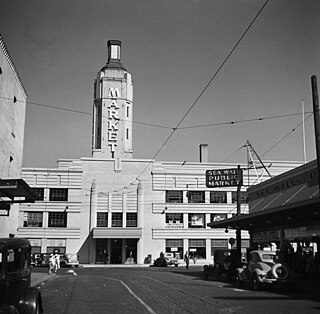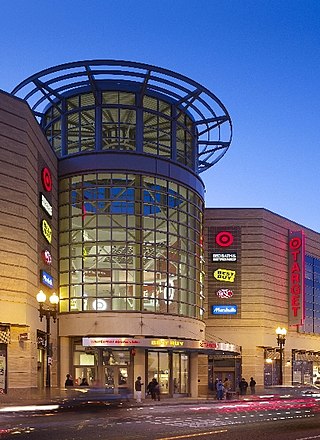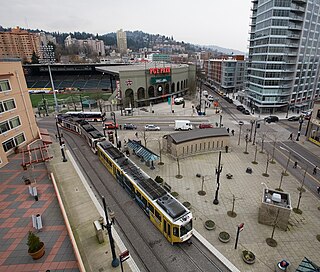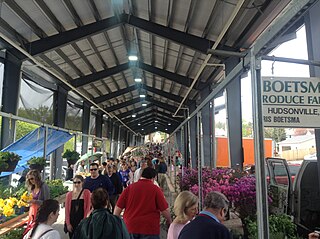Carroll Public Market | |
|---|---|
| Public market (dissolved) | |
| Location | SW Yamhill Street from First Avenue to Fifth Avenue Portland, Oregon |
The Carroll Public Market, also known as the Yamhill Street Market, was a fresh produce market that operated for twenty years on the sidewalks of SW Yamhill Street between First and Fifth avenues in Portland, Oregon, during the early decades of the 20th century. The organizational structure of the market eventually included 212 stalls and over 400 vendors who offered pricing by negotiation. One writer characterized the atmosphere as "loosely organized chaos." [1] The market was dissolved and replaced by the Portland Public Market in 1934.
Public markets often have been part of Portland history. An 1854 map of early Portland included two plats for market squares. One square on Fifth between Yamhill and Morrison was known as "Market Block," and it eventually became the site of two markets. [2] In 1872 a mixed-use building, the New Market and Theater, included a public market at the site of Portland's current Saturday Market. Changing demographics forced the market to close in the mid-1880s. [3]
Early in the 20th century, Evening Telegram editor and publisher John Francis Carroll began calling for a new public market, and in 1914 the Carroll Public Market was named in his honor. The market was located on the west bank of the Willamette River, near the site of the old Morrison Bridge, where vendors from farming communities outside of Portland could easily commute. Immediately the market became popular with customers seeking fresh produce. Customers dealt directly with farmers on the street and eliminated value added charges from middle men. [4]
The market quickly expanded to include not only the sidewalk space on Yamhill but adjacent buildings as well. Business owner Fred Meyer leased floor space in buildings that bordered the market, and he rented the space to vendors by the square inch. Meyer believed that vendors needed only a 2-foot aisle within stalls. [5]
Pedestrian and automobile traffic congestion along SW Yamhill Street continued to increase, turning the busy market into a target for urban planners in the 1920s. Planners wanted to move the market away from the sidewalks on Yamhill Street to a single building where inventory could be handled more efficiently and customers could be managed. [4] In 1934, the Carroll Public Market was demolished in favor of the new Portland Public Market on the waterfront at SW Taylor Street.
Fred Meyer is an American chain of hypermarket superstores founded in 1922 in Portland, Oregon, United States, by Fred G. Meyer. The stores operate in the northwest U.S., with locations in Oregon, Washington, Idaho, and Alaska. The company was acquired by Kroger in 1998, though the stores are still branded Fred Meyer. The chain was one of the first in the United States to promote one-stop shopping, eventually combining a complete grocery supermarket with a drugstore, bank, clothing, jewelry, home decor, home improvement, garden, electronics, restaurant, shoes, sporting goods, and toys. The Fred Meyer division is headquartered in Portland.

Yamhill District and Morrison/Southwest 3rd Avenue are light rail stations on the MAX Blue and Red Lines in downtown Portland, Oregon. Located in the Yamhill Historic District, it is the 3rd stop eastbound on the current Eastside MAX. It was also the eastern terminus of the transit mall. It originally served the Yellow Line from 2004 to 2009 until its relocation to the Portland Transit Mall.

Mall/Southwest 4th Avenue and Mall/Southwest 5th Avenue were a pair of light rail stations in Portland, Oregon, United States, served by TriMet as part of the MAX Light Rail system. Built into the sidewalk at Southwest Yamhill and Morrison streets between 4th and 5th avenues in downtown Portland, the Mall stations were served by the Blue and Red lines upon closing. They had also been served by the Yellow Line from May 2004 to August 2009.

Pioneer Square South and Pioneer Square North are a pair of light rail stations in Portland, Oregon, United States, served by TriMet as part of the MAX Light Rail system. Situated directly west of the Portland Transit Mall at Pioneer Courthouse Square in downtown Portland, they occupy the sidewalk on Yamhill and Morrison streets between Broadway and 6th Avenue. The stations consist of one side platform each; trains traveling eastbound stop at Pioneer Square South while trains traveling westbound stop at Pioneer Square North.

Meier & Frank was a prominent chain of department stores founded in Portland, Oregon, United States, and later bought by The May Department Stores Company. Meier & Frank operated in the Pacific Northwest from 1857 to 2006.

Downtown Portland is the central business district of Portland, Oregon, United States. It is on the west bank of the Willamette River in the northeastern corner of the southwest section of the city and where most of the city's high-rise buildings are found.

Pioneer Place is an upscale, urban shopping mall in downtown Portland, Oregon. It consists of four blocks of retail, dining, parking, and an office tower named Pioneer Tower. The mall itself is spread out between four buildings, interconnected by skywalks or underground mall sections. The footprint of the entire complex consists of four full city blocks, bisected by SW Yamhill and Fourth, bounded north-south by SW Morrison and Taylor Streets and east-west by SW Third and Fifth Avenues. In 2014, Pioneer Place was the third-highest selling mall in the United States based on sales per square foot, sitting just behind Bal Harbour Shops and The Grove at Farmers Market.
Fred G. Meyer was an American businessman who founded the Oregon-based Fred Meyer store chain, which had 63 stores in four western states at the time of his death. He was known for successfully introducing several innovative marketing concepts.

The Portland Public Market was a public market in Portland, Oregon, United States, built in 1933 at a widely advertised cost of $1 million. Controversial and ambitious, it was intended to replace the Carroll Public Market, centered at southwest Fifth and Yamhill Streets; the Portland Public Market was never popular and was in financial trouble virtually from the day it opened.

Pioneer Courthouse Square, also known as Portland's living room, is a public space occupying a full 40,000-square-foot (3,700 m2) city block in the center of downtown Portland, Oregon, United States. Opened in 1984, the square is bounded by Southwest Morrison Street on the north, Southwest 6th Avenue on the east, Southwest Yamhill Street on the south, and Southwest Broadway on the west.

DC USA is an 890,000-square-foot (83,000 m2) vertical power center, i.e. a multilevel enclosed urban shopping center anchored by big box stores. It is located in the Columbia Heights neighborhood of Washington, D.C. A Washington City Paper poll named DC USA the "Best Designed Retail Space" of 2009. The development is adjacent to the Columbia Heights station on the Green Line of the Washington Metro. It is also served by eight bus routes and has a 1,000-space parking garage.

Director Park is a city park in Portland in the U.S. state of Oregon. Opened in 2009 at a cost of $9.5 million, it covers a 700-space underground parking garage, which connects underground to the Fox Tower and the Park Avenue West Tower. Located in downtown on Southwest Park Avenue, the nearly half-acre urban park lacks any natural areas and contains little vegetation.

Providence Park is a light rail station on the MAX Blue and Red lines located in the Goose Hollow neighborhood of Portland, Oregon. It is named after the adjacent stadium, Providence Park. The station primarily serves Providence Park and residential areas around West Burnside Street. The station, consisting of separate eastbound and westbound platforms built into city sidewalks between SW 17th and SW 18th Avenues on SW Yamhill and SW Morrison Streets, opened on August 31, 1997.

The Portland Yamhill Historic District, located in downtown Portland, Oregon, is listed on the National Register of Historic Places.

The Stevens Building is a commercial and office building located in downtown Portland, Oregon, listed on the National Register of Historic Places. The 12-story building was designed by Whidden & Lewis. The design is similar to the Failing Office Building (1907) and Wilcox Building (1911), also by Whidden & Lewis. Construction began in August 1913 and was completed in 1914, with the building opening on May 1, 1914. The total construction cost was $375,000. The building is approximately 152 feet (46 m) tall.

Fulton Street Farmers Market is a farmers market that opened in 1922 in the Grand Rapids, Michigan area.

Claussen and Claussen was an architecture firm based in Portland, Oregon, that designed several prominent buildings in the first half of the 20th century. Some of the buildings have been added to the National Register of Historic Places, including the Roosevelt Hotel, the Park Heathman Hotel, the Loyalty Building, Ira Powers Warehouse, and Portland Van and Storage.
The James Beard Public Market is a proposed public market in Portland, Oregon. It is named after James Beard, a Portland-born chef and cookbook writer. The market was planned to be located at the west end of the Morrison Bridge in downtown Portland, in what are currently parking lots, but this site was dropped in November 2016 after concerns over pedestrian accessibility due to the bridgehead ramps. The developer, Melvin Mark Development, still plans to build a 17-story building at the same site. Original designs for the market called for it to have two halls, totaling 80,000 square feet (7,400 m2), along with 60 permanent and 30 to 40 temporary stalls for food vendors. Design for the market is being led by the Norwegian architectural firm Snøhetta.

Haymarket in Boston is an open-air market on Blackstone, Hanover, and North Streets, next to the Rose Fitzgerald Kennedy Greenway between the North End and Government Center.

Naito Parkway is a major thoroughfare of Portland in the U.S. state of Oregon. It was formerly known as Front Avenue and Front Street and was renamed in 1996 to honor Bill Naito. It runs between SW Barbur Boulevard and NW Front Avenue, and adjacent to Tom McCall Waterfront Park through Downtown Portland.